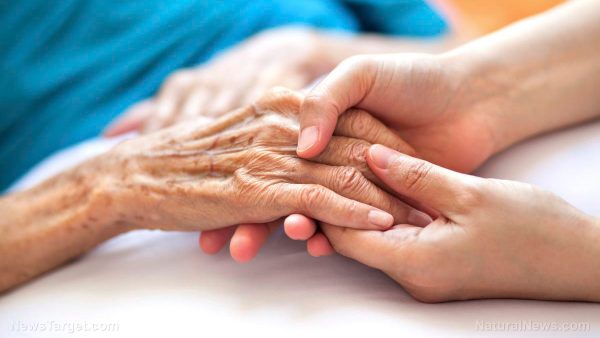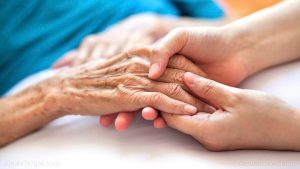
Parkinson’s disease – causes, side effects and treatments at NaturalPedia.com
Tuesday, June 12, 2018 by Ralph Flores
http://www.naturalpedia.com/parkinsons-disease-causes-side-effects-and-treatments-at-naturalpedia-com.html

Parkinson’s disease (PD) is a movement disorder caused by the inability of the nerve cells in the brain to produce dopamine. The progression of PD mostly occurs on one side of the body, with both sides being affected over time. In general, incidences of PD are isolated; however, some cases have been genetic, while others are potentially caused by factors in the environment.
The landmark symptom of PD is trembling of the hands, but this can progress to problems with gait and movement – including impaired motor function and speech.
Men who are at least 60 years old are typical candidates of PD; still, it can still affect women and those who are younger.
The condition is difficult to diagnose, as there are no tests for PD. Currently, there is no cure for PD.

Known risk factors and symptoms of Parkinson’s disease
Symptoms of PD start off mild, then develop gradually, which usually include the following.
- Tremors. The hallmark symptom of PD usually starts in the hand or arm, especially as the hand is relaxed or resting.
- Bradykinesia. The condition, which means “slowness of movement,” means that a person with PD has slower physical movements – which is evident while walking.
- Muscle rigidity. Increased stiffness and tension in the muscles can limit a person’s ability to move and make facial expressions. This can sometimes lead to dystonia, that is, a painful muscle cramp.
The condition can also interfere with other bodily functions. These include a loss of balance while walking, urinary incontinence, and even sexual dysfunction. Other symptoms include:
- Anosmia, or the loss of smell
- Nerve pain, which can range from sensations such as burning or coldness to numbness
- Dizziness, blurred vision, and even fainting when standing up, sitting, or lying down – a result of a sudden decrease in blood pressure
- Hyperhidrosis, a condition where a person sweats excessively
- Difficulty in swallowing and drooling
- Problems sleeping
Body systems affected by Parkinson’s disease
In most cases, PD comes with additional complications. These include:
- Cognitive difficulties. In later stages of PD, dementia may set in, which can be difficult to treat.
- Depression. Those with PD are prone to depression, as well as other emotional changes. These may also include fear, anxiety, and a loss of motivation.
- Fatigue. People with PD usually feel lethargic; the cause, however, is unclear.
- Pain. These can either be localized or felt throughout their bodies.
Food items or nutrients that may prevent or relieve Parkinson’s disease
A person with PD would do well to modify his diet to lower the risk of potential complications. Some recommended food items include the following.
- Fiber – Increasing a person’s fiber intake will help relieve constipation, a common side effect of PD. Some fiber-rich foods include barley, brown rice, wild rice, and bulgur.
- Legumes, except fava beans – Some varieties, including split peas, kidney beans, navy beans, and lentils are great sources of fiber. Fava beans, on the other hand, may interfere with PD medication if consumed in large quantities.
Protein, while it improves tissue growth and brain function, should be eaten sparingly as these also interfere with PD medication. In addition, avoiding added sugar is recommended, since it only adds empty calories.
Treatment and management options for Parkinson’s disease
Conventional treatment for PD, for the most part, is focused on medication. In particular, levodopa (L-DOPA) is used to temporarily relieve symptoms that affect a patient’s movement. In advanced cases – or when drug therapy fails – a device called a brain pacemaker is implanted to the brain through surgery to reduce tremor and other motor symptoms.
Still, there are natural methods to manage PD.
- Avoid coffee, since this triggers adrenaline production, making the tremors worse.
- Stay away from alcohol, as this adversely affects the central nervous system and can cause a condition called an essential tremor.
- Certain exercises can improve symptoms of PD. Regular use of hand weights, for instance, can increase stability in the hands and wrists, while tai chi may improve balance and gait.
- Acupuncture can relieve “frozen shoulder,” a condition that limits arm movement.
The following recommendations, on the other hand, may help manage incontinence – a common complication of PD.
- Managing a healthy weight can relieve bladder stress caused by the condition.
- Avoid smoking.
- Practice Kegel exercises, which are known to improve bladder control.
To deal with depression that comes with PD, long-term meditation and aerobic exercise can be used to manage it.
Where to learn more
- Beat Parkinson’s disease naturally
- Parkinson’s Disease Drugs Trigger Destructive Behaviors
- Study Links Parkinson’s Disease With Chemical Exposure
- Dealing with Parkinson’s Disease
Summary
Parkinson’s disease (PD) is a movement disorder caused by the inability of the nerve cells in the brain to produce dopamine.
PD progresses on one side of the body, with both sides being affected over time.
PD cases are isolated, but some cases have been genetic or even caused by environmental factors.
The landmark symptom of PD is trembling of the hands, which can lead to issues with motor function and speech.
Currently, no cure for PD exists; however, it can be managed with diet and exercise.
Sources include:
Tagged Under: Tags: Parkinson's Disease





